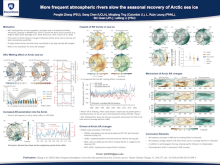More frequent atmospheric rivers slow the seasonal recovery of Arctic sea ice in the past 4 decades
Pengfei
Zhang
The Pennsylvania State University
Poster
In recent decades, Arctic sea ice coverage underwent a drastic decline in winter, when sea ice is expected to recover following the melting season. It is unclear to what extent atmospheric processes such as atmospheric rivers (ARs), intense corridors of moisture transport, contribute to this reduced recovery of sea ice. Here, using observations and a series of CEMS2 climate model simulations, we find a robust frequency increase in ARs in early winter over the Barents– Kara Seas and the central Arctic for 1979–2021. The moisture carried by more frequent ARs has intensified surface downward longwave radiation and rainfall, caused stronger melting of thin, fragile ice cover and slowed the seasonal recovery of sea ice, accounting for 34% of the sea-ice cover decline in the Barents–Kara Seas and central Arctic. A series of CESM2 model ensemble experiments, including CAM6 prescribed SST AMIP ensemble, CESM2 Large Ensemble (LENS2), and CEMS2 Tropical Pacific Pacemaker ensemble conducted by CVCWG/NCAR, are employed to explore the causes of the Arctic AR trends in the observation. These model ensembles suggest that the observed AR change cannot be fully explained by either external forcing, or tropical Pacific variability alone, but instead reflects the combined effect of anthropogenic forcing and internal climate variability. Considering the high climate sensitivity in CESM2, the contribution of tropical Pacific SST variability could be even higher in reality.

Poster file
zhang-pengfei-confronting-poster.pdf
(4.61 MB)
